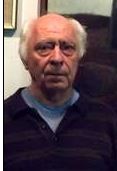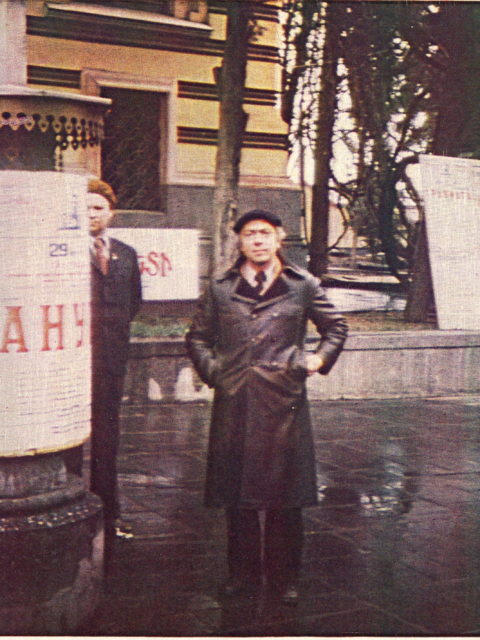Leaving Moscow?
By Stephen Poleskie
Contributing Columnist
“Just fill out this form and you can go. . . .” Jenya said, sliding a paper in front of me.
“But it’s in Russian, I can’t read Russia,” I replied.
“We know you can read it,” Jenya answered, giving me a wary smile.
“Can you help me with this?” I turned to Oleg, my other KGB minder who was also in the room. He shook his head and looked away.
We were at the Moscow Airport, but not in the lobby, or boarding area, nor any other public space. I had been picked up at my hotel by the Russians and brought here to this small, dimly lit room, obviously below ground. The airplane I was supposed to be on was scheduled to depart in about a half hour. What kind of game were these Soviets playing? Where were my CIA friends when I needed them?
I had been in the Soviet Union, as it was called back then, for the past month as a guest of the Union of Soviet Artists. My expenses were paid by the United States Information Agency. I delivered lectures on my art, as well as American graphic art, gave screen-printing demonstrations, and had exhibitions of my prints in Moscow, Leningrad, Vilnius, and Tbilisi. While my visit was supposed to be a straight cultural exchange, this was during the high time of the Cold War, and from the beginning it was apparent that there was a lot going on below the surface that I was only marginally aware of.
I put the form back on the table. “I can’t fill this out. You know that I can’t read Russian.”
Jenya and I had been playing games all month. “You are working for the CIA,” she would smirk at me, whereupon I would retort, “I am not working for the CIA; I am a Cornell art professor here on a cultural exchange. But you are member of the KGB.” “I am not a member of the KGB, just a free-lance translator.” However, she drove us around in a brand new Russian-made Fiat, at a time when the streets of Moscow were virtually empty of cars. We had been stopped once by a traffic policeman. When Jenya showed the officer her ID he practically fell over himself apologizing, and sent us quickly on our way.
On the first day that I arrived in Moscow, I had not been in my room more than three minutes when there was a knock on the door. It was the man from the US Embassy who had picked me up at the airport and brought me here. He didn’t say anything, but pointed to his lips and then up at the ceiling. Stepping inside he pulled me into the bathroom, where he turned on the sink and shower and flushed the toilet. Then he began to whisper in my ear what our plans for tomorrow would be.
From then on this man, who I shall call Joe, accompanied me everywhere. Officially he was my American translator, while Jenya was my Russian translator. So where was Joe now? Why had he abandoned me and let the Russians bring me to the airport?
I picked up the form from the table and handed it to Oleg. “Will you translate this?”
“I sorry,” Oleg muttered, “I don’t speak English.” He couldn’t draw either, even though he was supposed to be a graduate of Moscow’s finest art academy.
When I traveled by train I always had my own private compartment. Of course the windows were always blacked out so I couldn’t see what was outside. And if Joe and I were alone he was always fiddling with some shortwave radio that he produced from his luggage. This time there was no Joe, just Jenya, Oleg and me in the compartment, but also another man I had never seen before.
Shortly after the train pulled out of Leningrad station for some reason Jenya turned to me and said, “Would you like to draw something?” Taken by surprise, I replied; “What?” “You are supposed to be an artist . . . don’t you like to draw things?” Jenya shot back.” “But I have no drawing supplies,” I replied.
Whereupon the strange man, who up until this point had not been a party to our conversation, suddenly spoke up and volunteered in English; “I have it here a drawing pad and the charcoal pencils.” Pulling them from his bag he handed them to me. “So you can begin,” Jenya added, almost as a command.
Fortunately I had taught myself to draw some time back then. I announced that I would do a portrait of Jenya. As the train rumbled along I sketched Jenya while Oleg and the strange man watched me closely. After a short time I announced that the drawing was done. Everyone agreed that it was a fine portrait, and even looked like Jenya. However the strange man declared; “But Matisse could have done it in ten lines.”
“Oh, so you want a Matisse?” I replied. Turning to a clean page I quickly redrew Jenya in a Matisse-like style, using only nine lines.
I had been tested, but two can play at this game I thought. I turned to Oleg, “How would you draw Jenya?” He hemmed and hawed and finally took the pad and began. When Oleg was done with his child-like drawing, it was clear that he was not the artist he alleged to be.
“You must to fill out this form before you can go . . . the airplane will be leaving soon. If you miss it there is not another one until tomorrow.”
My mind flashed back to the day before. I had been sitting in an office in the US Embassy having my “debriefing,” when a stiff-necked Marine sergeant came in the door and saluted, saying; “Excuse me sir. You have got to leave the building immediately.”
We were hustled out onto the February Moscow streets without our coats. There was a man inside, in the very next room to where I had been, with a bomb in his vest, which he was threatening to explode if he didn’t get a visa. I couldn’t get my coat, but an embassy car quickly pulled up to take me back to my hotel.
That night there was a going away party for me at the ambassador’s apartment. My coat was returned to me there. I could still smell the tear gas that had been used to get the potential bomber out of the embassy.
“You must to fill out this form,” Jenya insisted. “You cannot leave until you do. . . .”
“But I can’t read Russian. . . .”
Why was I suspected of not being who I was? What had I done wrong? For one thing I had been giving demonstrations of screen printing, which had been suddenly stopped. Why? I learned that all printing in the USSR at that time was controlled by the state. In fact, as this was before computers and mobile phones, you needed to get a license just to buy a typewriter. I had brought some of the equipment that I used for printing with me, but the paints and solvents had been obtained from Switzerland.
As screen printing was virtually unknown as an artist’s technique in the Soviet Union at the time there was always a large group at my demonstrations. One day a man remarked rather rudely to me, “So what good is knowing this process to us? When you leave we cannot buy these materials here in Russia.” Now, as someone who had taught himself screen printing by reading a manual given out free by the Sherwin Williams paint company, here was a challenge I took up. “You can do this here,” I replied, “just bring me these things tomorrow and I will show you how.” So we set about making up a list of common materials that they could get hold of. When they brought them in I would use these items to do a screen print. The only thing I suggested, that they could not get, was a windshield wiper blade. I was going to use this in place of a squeegee. Windshield wiper blades were a rare item in the USSR at the time, so much so that drivers took the blades off and locked them in the car when they parked. So I suggested a piece of stiff cardboard instead.
The next day I did a demonstration using the materials they had brought. Little did I know that I was committing a subversive act? In a country where when the printing processes were tightly controlled here was a man teaching the masses how they could print things, like anti-government posters, using freely obtainable materials.
“So I have filled out the form for you,” Jenya announced, “just sign it and you can go.”
I looked at the form, what was I signing?
Oleg stood by the door smiling.
About the author:
 Stephen Poleskie’s writing has appeared in literary journals and anthologies in Australia, Czech Republic, Germany, India, Italy, Mexico, the Philippines, and the UK, as well as in the USA, and been three times nominated for a Pushcart Prize. He has published seven novels. His artworks are in the collections of numerous museums, including the MoMA, and the Metropolitan Museum, in New York, and the Tate Gallery, and Victoria and Albert Museum in London. He lives in Ithaca, NY, with his wife the author Jeanne Mackin.
Stephen Poleskie’s writing has appeared in literary journals and anthologies in Australia, Czech Republic, Germany, India, Italy, Mexico, the Philippines, and the UK, as well as in the USA, and been three times nominated for a Pushcart Prize. He has published seven novels. His artworks are in the collections of numerous museums, including the MoMA, and the Metropolitan Museum, in New York, and the Tate Gallery, and Victoria and Albert Museum in London. He lives in Ithaca, NY, with his wife the author Jeanne Mackin.
Website: www.StephenPoleskie.com

What an unusual story! The world would have been deprived of great writing and art work
had Steve Poleskie’s freedom to return to the United States been revoked by the Russians.
Unfortunately, the world peace movement has taken a turn for the worse. Nowadays,
it could have been Vladamir Putin and his buddy Donald Trump interrogating Steve
and demanding his signature on an unknown document.